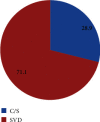Delivery Mode Preference and Associated Factors among Pregnant Mothers in Harar Regional State, Eastern Ethiopia: A Cross-Sectional Study
- PMID: 34055969
- PMCID: PMC8131132
- DOI: 10.1155/2021/1751578
Delivery Mode Preference and Associated Factors among Pregnant Mothers in Harar Regional State, Eastern Ethiopia: A Cross-Sectional Study
Abstract
Background: The right to prefer mode of delivery is a crucial component of compassionate and respectful care that fosters both maternal and neonatal well-being as the failure to respect the mother's interest increases to the risk of maternal depression and posttraumatic stress. Thus, the aim of the study was to assess delivery mode preference and associated factors among pregnant women.
Methods and materials: The study was conducted in two hospitals and two health centers. We used a cross-sectional study design incorporating 398 pregnant mothers attending an antenatal care follow-up from February to May 2018. The study excluded pregnant mothers with any previous uterine surgery including caesarean delivery from participation due to their restricted chance to prefer their mode of delivery. Data were collected by using a pretested questionnaire. Data were entered to EpiData Manager version 3.1 and exported to Statistical Package for the Social Sciences version 22 for analysis. Besides, the analysis included both the bivariate and multivariable analyses to check the association between dependent and independent variables. Finally, level of statistical significance was declared at P value < 0.05.
Result: The participant's level of response was 100% (398). The age of the mothers ranges from 15 to 45 years old. The delivery mode preference of the caesarean section (C/S) and spontaneous vertex delivery (SVD) was 115 (28.9%) and 283 (71.1%), respectively. The study revealed that planned 47 pregnancy [AOR, 1.76; CI: 0.89-3.47], young age [AOR, 12.9; CI: 0.23-7.1], and primigravida [AOR, 1.24; CI: 0.29-5.2] were among the variables associated with maternal preference of caesarean section. Conclusion and Recommendation. Nearly one-third of the mothers preferred caesarean delivery as their mode of delivery due to fear of labor pain and repeated vaginal examination by the care providers. This is particularly seen in women who had received higher education level, claim their pregnancy as planned, their choice of delivery at hospital, young aged, pregnant for the first time, and those who had visited antenatal care repeatedly. This implies that policy makers and stakeholders should exert due emphasis to ongoing desire of caesarean delivery as the procedure is not without risk, if it is done without indication. For researchers, we recommend to investigate the preference of mode of delivery in a much broader aspect.
Copyright © 2021 Fissaha Tekulu Welay et al.
Conflict of interest statement
The authors declare that there are no conflicts of interest regarding the publication of this paper.
Figures


Similar articles
-
Preference of mode of delivery and associated factors among mothers in East Africa: systematic review and meta-analysis.BMC Pregnancy Childbirth. 2025 Mar 3;25(1):232. doi: 10.1186/s12884-025-07287-8. BMC Pregnancy Childbirth. 2025. PMID: 40033288 Free PMC article.
-
Preference of cesarean delivery and its associated factors among pregnant women attending ante natal care at public health facilities of Debrebrehan City, Ethiopia: Cross-sectional study.PLoS One. 2024 Jan 31;19(1):e0296990. doi: 10.1371/journal.pone.0296990. eCollection 2024. PLoS One. 2024. PMID: 38295110 Free PMC article.
-
Respectful maternity care and associated factors among women who delivered at Harar hospitals, eastern Ethiopia: a cross-sectional study.BMC Pregnancy Childbirth. 2020 Feb 10;20(1):86. doi: 10.1186/s12884-020-2757-x. BMC Pregnancy Childbirth. 2020. PMID: 32041564 Free PMC article.
-
Maternal Preference, Mode of Delivery and Associated Factors among Women Who Gave Birth at Public and Private Hospitals in Hawassa City, Southern Ethiopia.Ann Glob Health. 2019 Aug 19;85(1):115. doi: 10.5334/aogh.2578. Ann Glob Health. 2019. PMID: 31441629 Free PMC article.
-
The choice of Caesarean section between clinical indication and patient autonomy: The physician between rock and hard place.J Eval Clin Pract. 2023 Oct;29(7):1068-1072. doi: 10.1111/jep.13820. Epub 2023 Feb 15. J Eval Clin Pract. 2023. PMID: 36793133 Review.
Cited by
-
The Preferences of Modes of Child Delivery and Associated Factors Among Pregnant Women in Southern Ethiopia.Pragmat Obs Res. 2022 Jul 15;13:59-73. doi: 10.2147/POR.S370513. eCollection 2022. Pragmat Obs Res. 2022. PMID: 35873720 Free PMC article.
-
Preference of mode of delivery and associated factors among mothers in East Africa: systematic review and meta-analysis.BMC Pregnancy Childbirth. 2025 Mar 3;25(1):232. doi: 10.1186/s12884-025-07287-8. BMC Pregnancy Childbirth. 2025. PMID: 40033288 Free PMC article.
-
Preference of cesarean delivery and its associated factors among pregnant women attending ante natal care at public health facilities of Debrebrehan City, Ethiopia: Cross-sectional study.PLoS One. 2024 Jan 31;19(1):e0296990. doi: 10.1371/journal.pone.0296990. eCollection 2024. PLoS One. 2024. PMID: 38295110 Free PMC article.
-
Preference and determinants of delivery mode in pregnant women with one cesarean scar: a cross-sectional study in two urban Ugandan public hospitals.BMC Pregnancy Childbirth. 2025 Feb 6;25(1):127. doi: 10.1186/s12884-025-07263-2. BMC Pregnancy Childbirth. 2025. PMID: 39915826 Free PMC article.
-
Knowledge and Attitude Toward Modes of Delivery and Possible Complications Among Women in Al-Baha Region, Saudi Arabia.Cureus. 2024 May 9;16(5):e59988. doi: 10.7759/cureus.59988. eCollection 2024 May. Cureus. 2024. PMID: 38854325 Free PMC article.
References
-
- Garthus-Niegel S., von Soest T., Knoph C., Simonsen T. B., Torgersen L., Eberhard-Gran M. The influence of women’s preferences and actual mode of delivery on post-traumatic stress symptoms following childbirth: a population-based, longitudinal study. BMC Pregnancy and Childbirth. 2014;14(1):p. 191. doi: 10.1186/1471-2393-14-191. - DOI - PMC - PubMed
MeSH terms
LinkOut - more resources
Full Text Sources
Other Literature Sources
Medical

